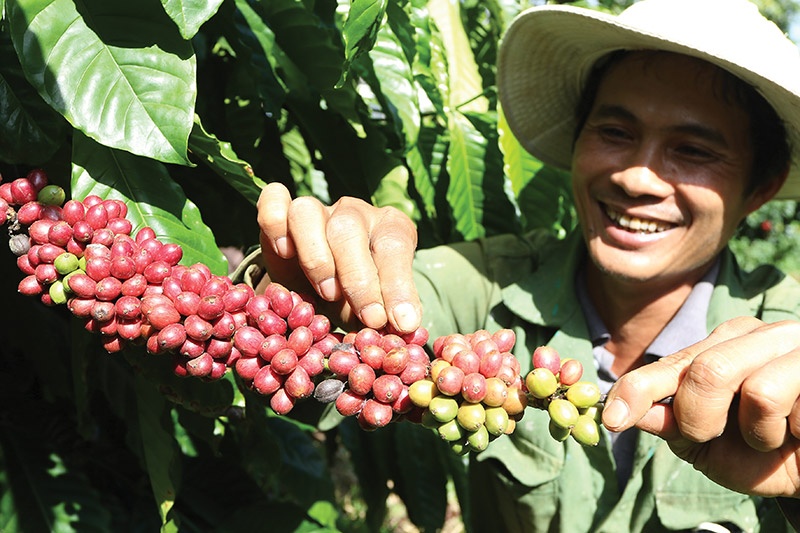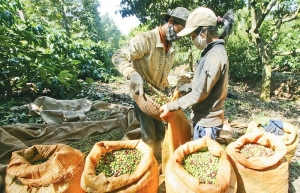Vietnam urged to stir up coffee competition
According to the International Coffee Organization, global coffee consumption is projected to grow by 3.3 per cent to 170.3 million 60-kg bags in the 2021-2022 crop year. The US Department of Agriculture predicted that global consumption is expected to rise by 1.8 million bags to 167 million, with the largest gains in the European Union, the United States, and Brazil.
 |
| Vietnam urged to stir up coffee competition, Le Toan |
The global coffee market will also record a 3.1 million bag supply deficit in the 2021-2022 season. This is partly because top producer Brazil harvests a smaller off-season crop. Meanwhile, Vietnam’s policy of coffee production has shifted to a new era with two objectives: to maintain its position as the world’s second-largest producer and exporter of green coffee beans and to double the added value by increasing productivity, quality, and value addition.
In the mid-1990s, the selling price of Vietnamese coffee at ports was $400-500 lower than the benchmark price used on the London commodity exchange. This gap has been narrowed as Vietnamese robusta coffee prices increasingly matched global prices. However, to reach an export value for coffee of around $6 billion by 2030, Vietnam likely needs to invest in deep processing.
A number of large local and foreign groups have poured capital into coffee processing. Intimex Group has a plan to increase the annual capacity of its Binh Duong plant to 20,000 tonnes by 2025 with the total investment capital of $100 million. Intimex aims to become Vietnam’s biggest instant coffee supplier by 2025.
India’s Tata Group has invested $65 million into its Tata Coffee Vietnam factory in the southern province of Binh Duong. The factory produces cold-dried coffee with an annual capacity of 5,000 tonnes of instant coffee for the global market.
Nguyen Quang Binh, an independent researcher in Ho Chi Minh City, doubts the competitiveness of processed coffee products in light of the current capacity of Vietnam’s coffee industry.
He wondered whether Vietnamese companies have sufficient financial capability and technologies to compete with global coffee brands with a long history of development like Nestlé or Starbucks.
“The market is the most important factory. For many years, Vietnam has provided raw materials to international roasters for a long. The country is lagging behind in terms of capital, technology, and ability to participate in the global distribution system,” Binh noted.
Vietnam has yet to reach its potential in increasing its coffee export turnover as the country mainly exports raw coffee with low added value. According to the Vietnam Coffee and Cocoa Association, the average price for a tonne of processed coffee is nearly $3,600, while the price of green coffee on the floor is only about $2,400.
“Global competition exists not only regarding quality but also brand. The development of coffee processing technology is never simple. While a processing facility can be developed in about two years, it takes at least a decade to establish a complete production and distribution chain. Thus, not all enterprises are successful to fulfil this mission,” Binh said.
With over 30 years of coffee research, Binh believed that it is crucial to ensure the quality of coffee right from the harvest. As a result, importers have to pay more for Vietnamese coffee, thereby increasing its brand awareness in the overseas market.
Under the coffee industry development project, Vietnam aims to increase the proportion of roasted, ground, and instant coffee exports in Vietnam to 30 per cent of total coffee export turnover in 2020.
As of present, the proportion only makes up 9 per cent of Vietnam’s coffee output. Some Vietnamese coffee producers, such as Vinacafe and Trung Nguyen, mainly develop their presence in the domestic market with exports to China and some US states which are home to overseas Vietnamese.
Last month, Wilson Li Wuqiang, a representative of Trung Nguyen Coffee Group in Shanghai, said that Trung Nguyen coffee is a familiar brand there. At first, Trung Nguyen mainly sold products like 3-in-1 instant coffee through border channels. In 2012, Trung Nguyen coffee products were sold in the Chinese market via its distributor Lam Vien. The move aimed to capitalise on China’s coffee market with an annual growth rate of 40-50 per cent.
However, there is no large coffee processing in Vietnam. Do Nam Hai, general director of Intimex Group, said that land and finance are two obstacles for businesses to invest in deep processing of instant coffee products.
Capital is always the dominant factor. Investing in an instant coffee processing system with a designed capacity of 3,000 tonnes per year and European technology costs about $300 million, according to Wuqiang. Many businesses want to invest in large processing plants but are limited in land access.
Even if Vietnam manages to secure sufficient funding, land, and deep processing capacity, the country’s coffee sector will still face significant challenges with the dominance of foreign groups, which account for nearly half of Vietnam’s annual coffee exports.
Nguyen Thanh Toan, deputy general director of Cafe Control JSC, has warned that foreign companies have built medium and large-scale processing factories in most of Vietnam’s main coffee-growing provinces.
“These companies, through agents, directly purchase green coffee. They invest in modern equipment and closed production lines to process high-quality coffee products and export them to the world market,” Toan said.
| Le Minh Hoan, Minister of Agriculture and Rural Development
Coffee production needs to be reoriented towards improving quality and protecting the environment. If Vietnamese coffee wants to reach out to the world market firmly and sustainably, it needs to rethink coffee production. Not only do we stop at producing delicious coffee beans, but we also focus on the traceability of coffee and its impact on the environment and climate change. Currently, the EU is a potential export market for Vietnamese coffee. However, since August 2020, when the EU-Vietnam Free Trade Agreement took effect, Vietnamese coffee has only gained a very small market share in this market. The Ministry of Agriculture and Rural Development has worked with Vietnamese diplomatic missions in Europe, discussing solutions to take advantage. In the near future, the ministry will develop a separate project on exporting agricultural products to the European market to determine the strategy of bringing Vietnamese coffee and agricultural products into major distribution systems. Businesses should be aware that if they want to go far, they must go together. The business community needs to form an alliance of coffee exporters to understand the needs, tastes, legal regulations, and technical barriers of the markets. | |
| Le Hoang Tai-Deputy director Vietnam Trade Promotion Agency
In 2022, we began been organising many activities to support coffee exports to many markets around the world. The Middle East is emerging as a potential export market for Vietnamese coffee businesses, with a large population of about 400 million people and a high standard of living. Middle Eastern countries import about 80 per cent of food items, equivalent to about $40 billion per year. It has a tax rate of only 0-5 per cent for goods imported from outside the bloc. Halal certification is a necessary condition for exporting coffee to this market. Additionally, when the UK economy improves, it is anticipated that the growth in the coffee trade will be positive. 2021 saw 34,000 tonnes of coffee imported from Vietnam to the United Kingdom, totalling $66.16 million. Instant coffee was the most popular type of coffee among British consumers. The UK-Vietnam Free Trade Agreement came into effect, bringing many prospects to the Vietnamese coffee industry in the UK market. Vietnamese coffee businesses need to quickly take advantage of the opportunities brought by the agreement. According to the deal’s commitment, after six years, the UK will eliminate import tax on 99.2 per cent of tariff lines, equivalent to 99.7 per cent of Vietnam’s export turnover. |
 | Can coffee supply of Vietnam satisfy Chinese demand? As the second-largest coffee exporter in the world, Vietnam is more than well equipped to represent a major supplier of China’s current and future demand for coffee. |
 | EU may be answer to shrinking bean share With Europeans seemingly loving Vietnamese coffee beans, businesses are struggling to increase exports to this important market that would bring much growth to the industry. |
What the stars mean:
★ Poor ★ ★ Promising ★★★ Good ★★★★ Very good ★★★★★ Exceptional
Related Contents
Latest News
More News
- Businesses ramp up production as year-end orders surge (December 30, 2025 | 10:05)
- Vietjet chairwoman awarded Labour Hero title (December 29, 2025 | 13:06)
- How to unlock ESG value through green innovation (December 29, 2025 | 10:03)
- AI reshapes media and advertising industry (December 29, 2025 | 08:33)
- FPT and GELEX sign deal to develop blockchain tech for global markets (December 29, 2025 | 08:29)
- Vietnam’s GDP forecast to grow by 9 per cent in 2026 (December 29, 2025 | 08:29)
- Women entrepreneurs are key to Vietnam’s economic growth (December 29, 2025 | 08:00)
- Vietnam's top 500 value-creating enterprises announced (December 27, 2025 | 08:00)
- The PAN Group shaping a better future with ESG strategy (December 26, 2025 | 09:00)
- Masan Consumer officially lists on HSX, marking the next phase of value creation (December 25, 2025 | 13:20)



 Tag:
Tag:





















 Mobile Version
Mobile Version